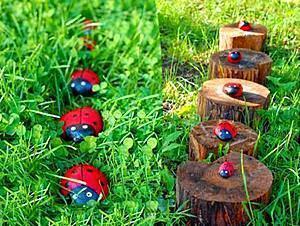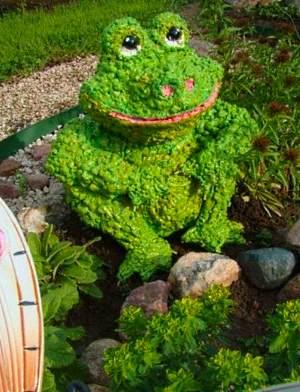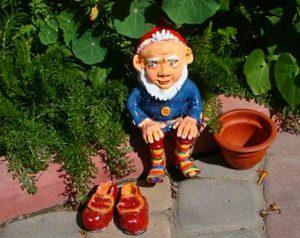We decorate our dacha and garden with handmade decorative figures
 Over the span of several years, people began to view their plots not as for planting crops, but as a space for fulfilling their fantasies. The desire to create barbecues, sandboxes, flower beds, fountains and other decorative structures on the garden area is amazing. And even if a garden the size of a city with its own lifestyles and principles of life blooms in general.
Over the span of several years, people began to view their plots not as for planting crops, but as a space for fulfilling their fantasies. The desire to create barbecues, sandboxes, flower beds, fountains and other decorative structures on the garden area is amazing. And even if a garden the size of a city with its own lifestyles and principles of life blooms in general.
If you are thinking of putting garden sculptures, this does not mean that you should install statues of ancient gods under 2 meters high, forged iron lanterns or huge marble fountains, just like near palaces and castles.
It may well be ordinary cute gnomes, birds or frogs. Of course, they can be purchased at specialty stores that sell such decorations. Why waste your time on this, and even money, when you can save all this and just create with your own hands the figure that you need. From a variety of materials, you can make any things, decorations for your garden plot.

The gnome remains one of the most common garden figurines. The gnome is the keeper of bushes and trees, therefore, in ancient times, he was placed next to them. People thought that it brings fertility and improves the appearance of the plantings in the garden. And gnomes also make the garden plot more attractive and interesting, bringing in it a little life and such a small, peculiar world. Suitable for any garden plot.
To make a gnome, you need a wooden barrel and knowledge of wood processing. From this barrel we cut the gnome we need, then paint it with paints.
 A difficult option would be a plaster gnome. Make a frame to make a plaster gnome. For the frame you will need: (thick wire or metal rods). Let's draw a drawing on paper in order to get a frame. Start sculpting from plaster only when you have made the frame. Having fashioned a gnome from plaster, he must be given time to harden, about 2-3 days. Then you can paint with garden paints.
A difficult option would be a plaster gnome. Make a frame to make a plaster gnome. For the frame you will need: (thick wire or metal rods). Let's draw a drawing on paper in order to get a frame. Start sculpting from plaster only when you have made the frame. Having fashioned a gnome from plaster, he must be given time to harden, about 2-3 days. Then you can paint with garden paints.
It looks unusual if you make decorative foam figures. This material is easy to use, it is moisture resistant and you can work with it with any tools. Practice and make a garden duck first. Think and decide what size your future duck will have, then draw outlines on a piece of Styrofoam. You will need to make the torso, head, legs, foam beak. Remember that the foam can crumble when cut. Therefore, you need to carefully cut out the body parts of the duck. Put all the pieces together and glue them, let the glue dry. So that all parts of the duck are glued properly, they need to be well glued on all sides. Once everything is dry, carefully trim away any unnecessary residue. Use a round metal pipe or block of wood for the neck.This will strengthen the head and torso in weather conditions, and since the foam is light it will make the duck heavier.
So that the neck does not differ from the head and body, glue it with foam. If the neck was made of a bar, secure it with cuts to make it stronger. Straighten your neck if there is excess styrofoam on it only when it is dry on it. Glue the foam duck's head to the neck, in the gap between the head and neck, hammer with foam and glue. Glue the legs, beak and wings to the duck. We will not paint it like that, you need to coat it with putty, and then wipe the excess when it dries. Now the figurine is ready for painting, it needs to be painted with facade paint.
If you decide to create decorative figurines, then you can also make an owl, hedgehog and chanterelles for the garden, they are ideal for your garden plot. The position of the figures should be so that it seems that they are real. You can put squirrels under the tree, near a pond of ducks, frogs, in the garden of gnomes and hedgehogs, etc.
When using such decorative figures, the dacha is very transformed. At the dacha I made some figures from one article on the same site "Decorating the garden with your own hands", it was called. Especially the cement mortar sheet turned out to be original for me. Handmade products somehow look more elegant than purchased factory ones. Therefore, I personally prefer to do everything with my own hands. It is economical, aesthetically pleasing, profitable and pleasant. In general, I do not see any disadvantages.